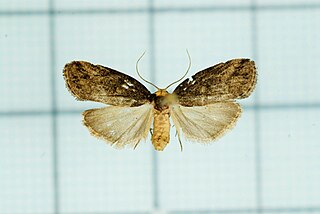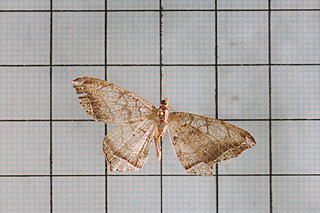
Eugoa is a genus in the family Erebidae, subfamily Arctiinae. The genus was erected by Francis Walker in 1858. They are found in India, Sri Lanka, Myanmar and Borneo.

Ugia is a genus of moths in the family Erebidae erected by Francis Walker in 1858.

Oxymacaria is a genus of moths in the family Geometridae described by Warren in 1894.

Plutodes is a genus of moths in the family Geometridae erected by Achille Guenée in 1857.

Sauris is a genus of moths in the family Geometridae erected by Achille Guenée in 1857.

Eugoa aequalis is a moth of the family Erebidae first described by Francis Walker in 1858. It is found on Borneo, Peninsular Malaysia and Sumatra. The habitat consists of lowland areas, where it is found in various forest types, including heath, coastal and secondary forests.
Eugoa bipuncta is a moth of the family Erebidae first described by Franciscus J. M. Heylaerts in 1891. It is found in Sundaland and on Sulawesi and the Lesser Sunda Islands. The habitat consists of lowland forests.
Eugoa bipunctata is a moth of the family Erebidae first described by Francis Walker in 1862. It is found on Borneo and in Singapore. The habitat consists of lowland forests.
Eugoa crassa is a moth of the family Erebidae first described by Francis Walker in 1862. It is found on Borneo. The habitat consists of various types of lowland forests, including limestone, wet heath forests and alluvial forests.
Eugoa humerana is a moth of the family Erebidae first described by Francis Walker in 1863. It is found on Borneo, Peninsular Malaysia, Sumatra and Java. The habitat consists of forests.
Eugoa inconspicua is a moth of the family Erebidae first described by Francis Walker in 1863. It is found on Borneo. The habitat consists of various lowland areas, including alluvial forests, wet heath forests and swamp forests.
Eugoa indeclaratana is a moth of the family Erebidae first described by Francis Walker in 1863. It is found on Borneo. The habitat consists of lowland forests.
Eugoa sexpuncta is a moth of the family Erebidae first described by George Hampson in 1911. It is found in Papua New Guinea.
Eugoa tineoides is a moth of the family Erebidae first described by Francis Walker in 1862. It is found on Borneo. The habitat consists of lowland forests.

Eugoa trifascia is a lichen moth in the family Erebidae, subfamily Arctiinae. The species was first described by Francis Walker in 1862. It is found on Peninsular Malaysia and Borneo. The habitat consists of lowland to lower montane forests.
Eugoa trifasciata is a moth of the family Erebidae, subfamily Arctiinae. The species was first described by Snellen in 1880. It is found on Sumatra and Borneo. It is found in a wide range of lowland forest habitats, including heath forests and regenerating alluvial forests.
Eugoa turbida is a moth of the family Erebidae first described by Francis Walker in 1862. It is found on Borneo. The habitat consists of lowland forests.
Eugoa vagigutta is a moth of the family Erebidae first described by Francis Walker in 1862. It is found on Borneo. The habitat consists of alluvial forests, forest on limestone, lowland dipterocarp forests and open coastal forests.

Manoba major is a moth in the family Nolidae. It was described by George Hampson in 1891. It is found in India, Taiwan, Japan, Myanmar, Singapore, as well as on Borneo, Java, Vanuatu and New Caledonia. Its habitat is coastal areas near mangroves.
Earias luteolaria is a moth of the family Nolidae first described by George Hampson in 1891. It is found in India, Sri Lanka, Borneo, Hong Kong and Australia.







